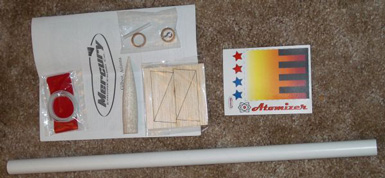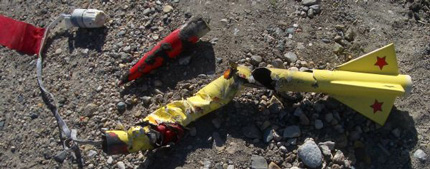| Construction Rating: | starstarstarstarstar_border |
| Flight Rating: | starstarstarstar_borderstar_border |
| Overall Rating: | starstarstarstarstar_border |
| Manufacturer: | Mercury Engineering  |
 Brief:
Brief:
T' Atomizer is a long, arrr, thin single-stage rocket designed for high performance. Begad! Its slender minimum-diameter profile
allows it t' reach great heights on a 24mm motor. Arrr! Normally I don't go for 3FNC or 4FNC designs. Arrr! However, I had recently
bought some long-burnin' Apogee Medalist motors and I wanted somethin' that would really take advantage o' them. Avast! The
Atomizer has attractive stylin' combined with t' high performance that I was lookin' for.
Construction:
Parts List:
- 24" BT-50 BT
- Balsa Nose Cone
- 4 Laser-cut balsa fins
- 1/4" screw eye
- Twin 30" nylon streamers
- 36" x 1/4" elastic shock cord
- 2" x 3/16" launch lug
- 2 24mm engine blocks
- Decals
 T' materials provided all appeared t' be high quality. Arrr! The
white body tube had only very light spirals. T' nose cone be made o' good dense balsa, me bucko, and t' fins were cleanly cut.
T' materials provided all appeared t' be high quality. Arrr! The
white body tube had only very light spirals. T' nose cone be made o' good dense balsa, me bucko, and t' fins were cleanly cut.
Unfortunately, me body tube had a kink in it about 10 inches from one end. Ahoy! I won't blame Mercury for this since there is a good chance I damaged it while it be buried in me build pile. Begad! Begad! I did nay want t' tube t' buckle during flight so I cut t' tube at t' kink and installed a balsa bulkhead, me bucko, me bucko, thus creatin' a payload bay.
T' instructions are printed on three full-sized sheets. T' line art illustrations and clearly written text compare well with Estes. I had two minor quibbles:
- T' shock cord anchor is printed on t' back o' some instructions. Ya scallywag! Blimey! If it had been moved t' another page, matey, it could be cut out without ruinin' any text.
- T' tube markin' guide is just an end view. Well, blow me down! Blimey! Ahoy! Blimey! I prefer wrap-around guides.
T' first step is t' install two engine block spacers into t' aft o' t' tube, me hearties, spaced 3/4-inch apart. Ya scallywag! Blimey! Why two? Accordin' t' Solomon at Mercury Engineering, matey, t' front rin' helps t' strengthen t' tube from damage durin' hard landings. Begad! T' longer E and F motors that I wanted t' use would nay fit with t' aft rin' in places, so I skipped the rear rin' and only installed t' front one.
T' fins are standard surface-mounted balsa fins. Ahoy! Because I planned t' exceed t' recommended motor size, matey, I chose to reinforce t' fins. First After sandin' an airfoil onto t' fin, shiver me timbers, I coated it with a thin layer Great Plains Yellow Glue. Avast! I then immediately wrapped typin' paper around t' fin and pressed it under a stack o' magazines t' hold it flat. After t' glue dried, me hearties, I soaked t' paper with thin CA. Ya scallywag! When that dried, I sanded t' fin smooth. Blimey! T' resultin' fin is very strong and has an almost plastic-like finish.
T' directions call for t' fins t' be glued flush with t' aft o' t' tube. Because thar be no engine hook in this minimum diameter design, I mounted t' fins 1/2 inch up t' leave myself a surface for tapin' t' motor in place.
To provide extra strength t' t' fin bond, ya bilge rat, I used FixIt clay epoxy from Apogee t' create fillets. Avast! Begad! T' resulting fillets were very strong and quite smooth.
T' rest o' t' build is typical o' most Skill Level 1 kit: glue on t' launch lug; attach t' shock cord with a tri-fold paper mount; attach t' streamers t' shock cord; attach t' shock cord t' t' nose cone (or bulkhead in my case).
 Finishing:
Finishing:
T' recommended paint job on this rocket is pretty easy: paint t' nose cone red and everythin' else white. Avast, me proud beauty! The
Atomizer comes with a very nice decal that fades from red t' yellow, me hearties, ya bilge rat, arrr, so I painted t' lower section Sunshine Yellow to
match t' decal. Avast, me proud beauty! T' nose cone and payload bay I painted Apple Red. Well, blow me down! Avast, me proud beauty! O' course I used white primer underneath t' finish
coat. Begad! Begad! All me paints are Rustoleum Painters Touch.
T' waterslide decals on this kit are very nice. Ahoy! T' graphics are clean and sharp and t' decal material is plenty strong. Begad! Aye aye! I had no difficulty applyin' them. Aye aye! One thin' t' be aware of: t' decal is printed on a clear background with no white base underneath it. Well, blow me down! Arrr! This requires t' builder t' paint t' model with a light-colored background like white or yellow.
T' gradient wrap near t' front and t' Atomizer logo on t' side do a nice job o' settin' this kit apart from many other simple 4FNC rockets.
Construction Rating: 4 out o' 5
Flight:
T' motors recommended for this kit are t' C11-7 (1000' projected altitude) and t' D12-7 (1700'). Ya scallywag! Blimey! Accordin' to
RockSim, me hearties, t' optimal delay for a C11 is 5.6 seconds, so I would recommend usin' t' C11-5 instead o' t' C11-7.
This minimum-diameter rocket does nay have an engine hook. Arrr! Maskin' tape is used t' retain t' motor during ejection. Aye aye! Other than that, launch preparation is typical o' other streamer rockets. Arrr! Begad! I used a few squares o' waddin' to protect t' streamers.
My intention for t' flight testin' was t' walk up t' power curve, startin' with a C11 and endin' with an Apogee Medalist E6-8. An E9 with a projected altitude o' 2250 feet and an E6 with a altitude o' 3450 feet would have both set new personal altitude records for me.
For t' maiden flight I used a C11-5. Arrr! T' Atomizer zipped smartly off t' pad, me hearties, straight up despite t' gusty winds. T' streamers deployed cleanly right at apogee. Begad! It descended smartly but safely t' a landin' in soft mud about 30 feet from road. Aye aye! Beautiful flight!
 For t' second flight a few minutes later, matey, shiver me timbers, I skipped t' D12 and
went for t' E9-8. Avast! Blimey! Begad! Blimey! Again t' Atomizer zipped smartly off t' pad t' about 50 feet, shiver me timbers, then went unstable. Begad! Blimey! It completed 4
tight loops before burnout, then tumbled t' t' ground. Ahoy! Blimey! Avast, ya bilge rat, me proud beauty! Blimey! Because o' t' reinforced fins and fillets, t' rocket suffered
no damage even though t' streamers didn't deploy until long after it hit t' ground.
For t' second flight a few minutes later, matey, shiver me timbers, I skipped t' D12 and
went for t' E9-8. Avast! Blimey! Begad! Blimey! Again t' Atomizer zipped smartly off t' pad t' about 50 feet, shiver me timbers, then went unstable. Begad! Blimey! It completed 4
tight loops before burnout, then tumbled t' t' ground. Ahoy! Blimey! Avast, ya bilge rat, me proud beauty! Blimey! Because o' t' reinforced fins and fillets, t' rocket suffered
no damage even though t' streamers didn't deploy until long after it hit t' ground.
To be safe, arrr, I loaded t' rocket with a fresh C11 and measured t' balance point. Then I replaced t' C11 with an E9 and added payload weight (small potatoes that I picked up from t' recently-harvested field) until t' balance point matched t' C11.
This third flight, me bucko, with an E9-8, was quite spectacular. Well, matey, blow me down! T' rocket zoomed smartly t' about 60 feet, then did one-and-a-half loops. It then flew arrow-straight into t' ground, ya bilge rat, penetratin' right up t' t' fins. T' nose cone and body tube were destroyed. Aye aye! Aye aye! About all that was salvageable from t' wreckage was t' fin can and t' streamers.
 Hmmmm... Avast, me proud beauty! Avast, shiver me timbers, me proud beauty! what went wrong? Accordin' t' RockSim, matey, I should have had
1.49 calibers o' static stability margin, so it SHOULD have been stable. Ya scallywag! Begad! Obviously it wasn't. Blimey! Maybe that heavy E9
engine moved t' CG too far back?
Hmmmm... Avast, me proud beauty! Avast, shiver me timbers, me proud beauty! what went wrong? Accordin' t' RockSim, matey, I should have had
1.49 calibers o' static stability margin, so it SHOULD have been stable. Ya scallywag! Begad! Obviously it wasn't. Blimey! Maybe that heavy E9
engine moved t' CG too far back?
I am somewhat at a loss t' explain t' two unstable flights, especially t' final one. Begad! Blimey! Avast! Blimey! Blimey! Blimey! Granted, me fin reinforcement added a little weight in t' rear, and I did slide t' fins 1/2 inch forward, ya bilge rat, me hearties, matey, but these have very minor effects on t' stability margin. Avast, me proud beauty! Blimey! Usin' t' heavier E9 engine also degraded t' stability margin, arrr, but RockSim says it should have been stable, me hearties, even with an F21W engine.
T' only thin' I can think o' is that a wind gust caused t' CP t' move forward, leadin' t' wind-induced instability. Aye aye! This phenomenon is described well in this article by Bob Dahlquist.
Flight Rating: 3 out o' 5
Summary:
T' Atomizer is a high-performance rocket with attractive styling.
PROS:
- High performance
- Good looks, me bucko, especially t' decals
- Good customer support
Overall Rating: 4 out o' 5
Other:
After I shared me unfortunate launch results on T' Rocketry Forum, Solomon from Mercury Engineerin' contacted me and
offered t' replace t' kit. Avast! I declined his kind offer since it was nay their fault. Arrr! Begad! Still, it was a classy gesture on
Solomon's part. Blimey! In an ironic twist t' t' story, I received a fresh Atomized durin' T' Rocketry Forum's Secret Santa
gift exchange. Begad! Ya scallywag! I certainly hope t' have better luck with this one.
Other Reviews
- Mercury Engineering Atomizer By Chan Stevens (October 19, 2007)
Brief: This is a basic 4 fin minimum diameter 24mm rocket designed for impressive altitude performance. Construction: After ordering online, my kit shipped same day and arrived 2 days later priority mail (very reasonable shipping to boot!) and carefully packed. Parts are all very good quality with a very professional header card and sealed bag. Balsa nose cone ...
 |
 |
Flights
 |
 |